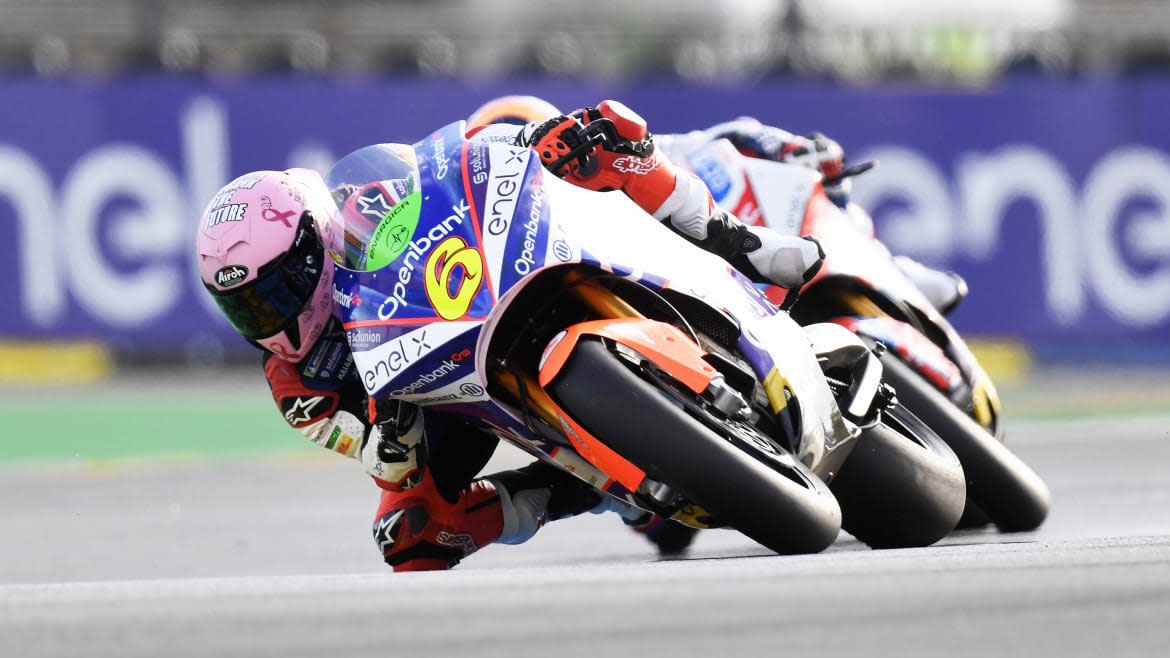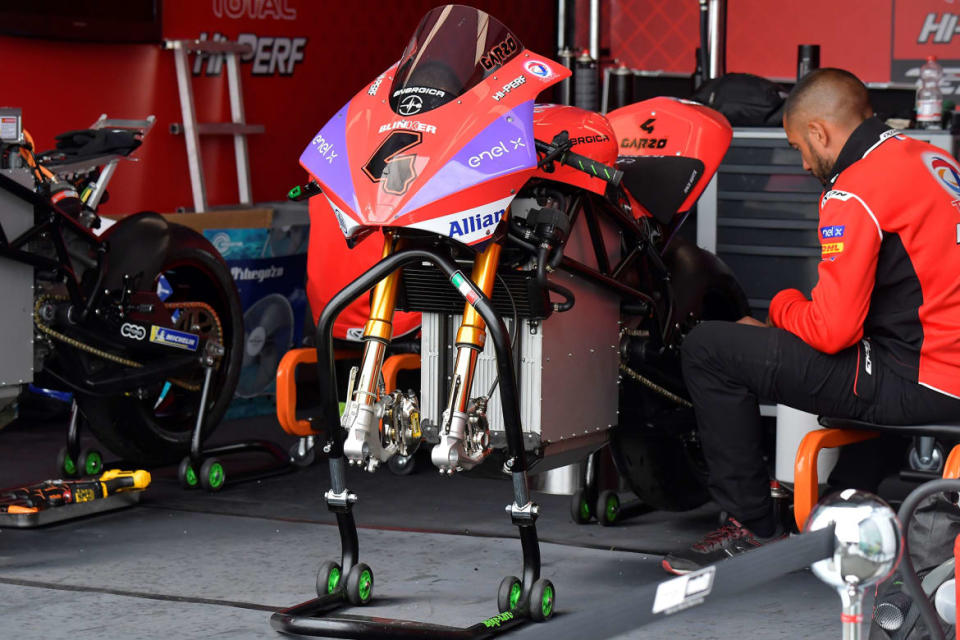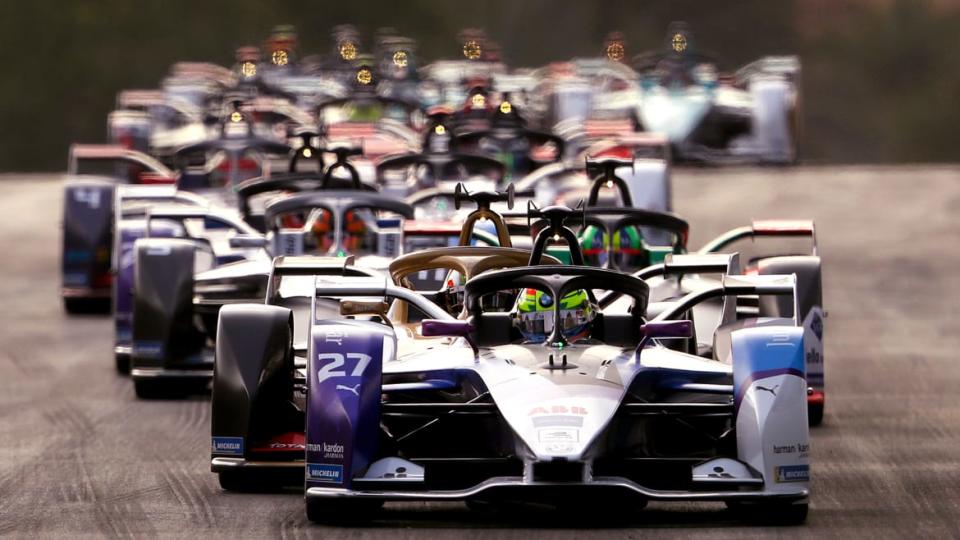Electric Vehicles Are Revving Up a Takeover of Motorsports

Accelerating climate change and skyrocketing gas prices have forced people around the world to rethink their transportation and entertainment choices. While governments and corporations dither and delay the transition to renewable energy sources, carbon-neutral pioneers have emerged from a surprising field: electric motorsports.
Nicolas Goubert is the executive director of the FIM MotoE World Cup, a racing series that only features electric motorcycles. “Motorsports have to [promote] up-to-date technologies,” Goubert told The Daily Beast.
Goubert believes that spurring and showcasing technological change is one of racing’s core missions and a crucial part of its appeal. The history of the sport helps bear this out: As early as the early 20th century, Harley-Davidson—arguably the most famous motorcycle brand in the world—honed and promoted its engines through on- and off-road races. In 2011, amid rising global concern about the environmental and economic costs of fossil fuels, Formula E established the first all-electric single-seater car racing championship. More than a decade later, global electric car sales have grown from 43,000 units per year to an eye-popping 6.6 million. Formula E has grown into a worldwide entertainment brand, reaching over 316 million viewers in 2021 and netting $92 million in profit despite the COVID-19 pandemic.
The Electric Vehicle Revolution Is Coming for Trains
Inspired by Formula E, MotoE was launched in 2019 as an all-electric motorcycle racing series. MotoE’s first season featured just four events. It now hosts six events throughout the year, with two races every weekend.
Goubert attributes MotoE’s rapid growth partly to its technology. Weight can limit a motorcycle’s performance, and the electric powertrains—the group of components starting with the motor that pushes motorcycles forward— in MotoE’s bikes initially were so hefty that they restricted the series’ races to six laps. In the four seasons since MotoE’s founding, MotoE bikes have shed about 33 pounds in weight, allowing them now to race for eight laps at speeds of up to 168 mph—comparable to Moto3 gas-powered motorcycles.
The races are fiercely competitive. MotoE’s last race at TT Circuit Assen featured 16 riders. The difference between the first and last place finishers? Less than six seconds.
Also, since they have fewer moving parts, the electric powertrains featured in MotoE bikes are far more reliable than combustion engines. Mechanical failures are common occurrences in racing series featuring gas-powered motorcycles. Not only do they make for disappointing viewing, they also create a safety risk to riders. Since MotoE’s founding, not a single motorcycle has experienced a major mechanical failure during a race.

A staff member works on Spanish driver Hector Garzo’s Tech3 E-Racing machine at a stand during the Grand Prix Germany at the Sachsenring Circuit on July 7, 2019, in Hohenstein-Ernstthal, eastern Germany.
MotoE has also wisely recognized that pivoting to electric is a good way to build a fanbase among Millennials and Zoomers—who are far more concerned about climate change than older generations.
In fact, the sport has specifically tailored the format of its racing series to the Netflix and Tik Tok generations. MotoGP races featuring gas-powered motorcycles typically run for about 40 minutes. MotoE races last just 15 minutes, taking up less time than an episode of Derry Girls or Big Mouth, and making it easier to digest competitions in bite-sized clips consumed on social media. The short races mean the motorcycles don’t need to be recharged mid-race—getting around concerns over the batteries’ ability to keep going.
MotoE’s success has not gone unnoticed by the rest of the motor vehicle world. In 2023, Ducati will join MotoE as the series’ official and sole motorcycle supplier. In 2021, Ducati sold over 50,000 gas-powered motorcycles and generated close to a billion dollars in revenue. Ducati’s partnership confirms MotoE’s legitimacy as a motorsports leader.
As exciting as MotoE is, the motorcycles featured in the series are prototypes built solely and specifically for racing. To combat climate change, electric vehicles need to be available to the general public, with prices and performance comparable or superior to their combustion-driven counterparts. Born in a Santa Cruz garage, Zero Motorcycles is working to make that happen.
Zero Motorcycles is an electric motorcycle manufacturer headquartered in the U.S. The company produced its first prototype motorcycles in 2006. “The product was basically a Franken-bike mountain bike with slapped-on parts,” chuckled Dan Quick, Zero Motorcycle’s director of communications.
What If the Highway Could Charge Your Electric Vehicle?
Zero is the longest-running all-electric motorcycle manufacturer in the U.S.—though Quick told The Daily Beast that boasting that fact feels like “bragging about being the tallest kindergartener.” The company strives to incorporate the latest electric technologies into their bikes, he said, at a price premium of 20 percent or less compared to their combustion-driven competitors. Zero’s most affordable bikes start at around $10,000. For perspective, a new Harley-Davidson can cost anywhere from $11,000 to $50,000.
Zero’s latest, top-of-the-line model, the SR/S, comes available with an improved battery pack and electric powertrain, allowing the bike to deliver 110 horsepower, 140 ft-lb in torque, and reach up to 124 mph in speed. The SR/S has a range of 227 miles and takes less than 3 hours and $2 to recharge. The cost? $22,695. Compare that to Yamaha’s top gas-powered touring bike, the FJR1300ES—which starts at $18,199, has a range of t 237 miles,142 horsepower, but just 99 ft-lb of torque.
Though there is still a performance gap between gas-powered and electric motorcycles, it’s closing rapidly, and the price difference is small enough to make electric motorcycles an attractive option for certain consumers.

Alexander Sims of Great Britain driving the BMW iFE.20 on track during the ABB FIA Formula E Championship in Riyadh, Saudi Arabia.
According to Quick, Zero’s customers tend to fall into three different categories. The first is made up of motorcycle enthusiasts seeking to add an electric bike to their collection. While they may purchase a Zero as a sort of novelty, Quick argued many come to favor the electric motorcycle over their combustion-driven models, because they’re cheaper to “refuel,” have more reliable powertrains, and require little of the routine maintenance associated with combustion-driven engines (such as oil changes, valve adjustments, gasket services, and winterization).
“You can neglect [an electric motorcycle] for months on end… then throw a leg over and ride,” Quick said.
Next are the returning riders. These individuals tend to be older. They rode motorcycles when they were younger but stopped, either due to an accident or a life event, such as having children or moving across the country. Now they’re interested in riding again, and they view electric motorcycles as a premium product—sort of a “two-wheel Tesla.”
The third and, in Quick’s view, the most exciting group is the new riders. These “early adopters” span a broad swath of demographic categories, but tend to skew younger. They are more comfortable with technology. They want to try something new. They’re not caught up in traditional American motorcycle culture and appreciate the smooth ride and low environmental impact of electric motorcycles
“These are people that don’t look, sound, or act like your average ‘Boomer’ Harley rider, which has been the bulk of the industry for years,” Quick said. These customers, who traditional motorcycle companies have failed to reach, represent the future of motorcycling.
Zero declined to disclose sales figures to The Daily Beast. Through vehicle registrations, MotorCycles Data determined that Zero sells between 3,000 to 4,000 motorcycles per year and that its sales have grown by about 41 percent since 2019.
In Quick’s view, there’s no better way to turn customers on to electric technologies than to have them ride an electric vehicle themselves. “It’s an experience that has to be had,” he said.
The Electric Car Battery of the Future Could Be Made From Trees
The leaders of the FIM E-Xplorer World Cup recognized that when they established the new, all-electric off-road motorcycle racing series. E-Xplorer will debut this fall and plans on conducting five races in locations ranging from the United States to Europe. The series is collaborating with major motorcycle manufacturers, including LiveWire, Yamaha, and Honda, and will include a team led by American motocross legend James Stewart, known to motorcycle aficionados around the world as “The Fastest Man on the Planet.”
Carina Munte, an executive and co-founder of E-Xplorer, told The Daily Beast that the series seeks both to provide competitive racing and to promote electric motorcycles as a viable transportation option. Like MotoE, E-Xplorer plans on using the series to develop and showcase new battery technology and advanced motorcycle designs. Unlike MotoE, all motorcycles featured in E-Xplorer will be built for everyday use, not just for racing.
“The bikes you see...in the races are the bikes you and I can buy,” said Munte. “The next day you can go to Honda, to Sur-Ron, to whoever, and you’re going to be able to purchase the same motorbike.” Fans will even be able to take them out for test drives at E-Xplorer events.
According to Munte, recruiting new electric motorcycle customers for its manufacturing partners is one of E-Xplorer’s main goals. In her mind, it’s not just a good business strategy. Promoting environmentally sustainable entertainment and transportation is simply the ethical thing to do.
“Making a mark without leaving a trace,” said Munte. “In the end, [it’s] what everybody wants.”
Get the Daily Beast's biggest scoops and scandals delivered right to your inbox. Sign up now.
Stay informed and gain unlimited access to the Daily Beast's unmatched reporting. Subscribe now.

